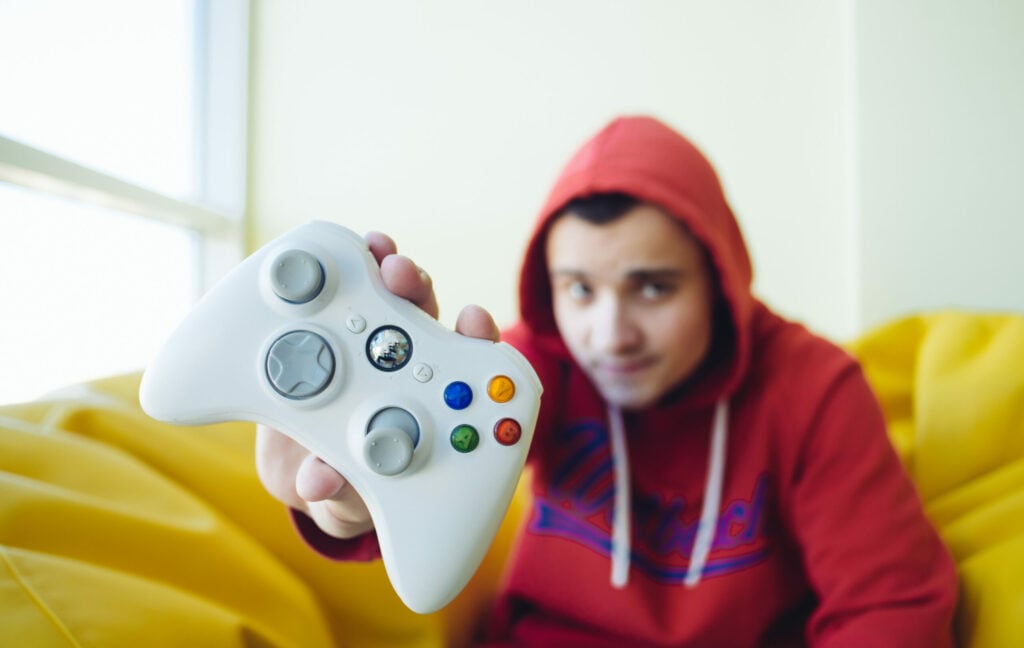Can video games help level up therapy for kids?
Reviewed by Stephanie Steinman, PhD, CSAC


When the country was searching for answers after the Columbine High School shooting in 1999, many public conversations focused on the killers’ use of first-person shooter video games like Doom.1 I was 21 at the time, and I remember this well because my boyfriend and a number of our friends also played that game. This period became the origin story for our cultural history of connecting video games with acts of violence.2


In the years since, the American Psychological Association (APA) has found insufficient evidence for that connection, though it does note that the use of violent video games is sometimes linked to outcomes like yelling or pushing.3 Other studies suggest that some video games might actually have mental health benefits—as long as they’re played in moderation and with parental controls for littler kids.
Today more than 90% of kids over age two play video games, with children ages 8 to 17 playing for an average of 1.5 to 2 hours a day.4 Gaming can be a way for them to spend time with peers, use their imaginations, and feel in control when they may not have that same feeling in real life.
As gaming becomes common in kids’ daily lives, some mental health professionals have started to embrace the medium as a way to connect with and treat young clients. While gaming isn’t free of risk, it’s worth considering how video games used responsibly in therapy can benefit kids and their mental health.
Therapeutic uses for video games
The success of mental health treatment ultimately rests on the relationship between the therapist and the client. It can be hard for providers who work with kids, especially teens, to build trust in a short amount of time. Connecting with young clients through video games is one way to move that process along more quickly.
Josué Cardona, MS, is an engineer turned therapist and the creator of Geek Therapy, which advocates for integrating popular media into therapeutic, educational, and community practice. For kids who consider themselves gamers, says Cardona, it’s about helping them bring a piece of their personal world into the therapy room. “When we do that, a big part of what we’re saying is, ‘I accept a part of you that may not be accepted in other circles,’” he explains.
For kids who play more casually, incorporating gaming into therapy can be a novelty that helps put the child at ease. For example, Cardona might offer a client the chance to join him in playing Minecraft, a game where your avatar constructs a virtual world. This is his way of meeting young people where they are: “As we’re playing, we’re having a conversation about school or home or anything else they need to talk about.”
Treating specific conditions
A therapist might use video games to address conditions such as:
Impulsiveness: Cardona has seen colleagues help kids strengthen their impulse control using a method called “controllers down.” “If you’re playing Mario Kart, for example, and the therapist says, ‘Controllers down,’ you have to put it down, even if you’re in the middle of a race,” he says. “This is really difficult for kids with impulse control concerns, but it’s a good way to practice and reflect on those feelings in the moment.”
Anxiety and stress: Studies show that some off-the-shelf games designed for casual play can help reduce stress and anxiety.5 This offers therapists a way to recreate stressful or anxiety-producing stimuli in the safety of a controlled environment. “Oftentimes in therapy, we talk about things that happen outside the room,” Cardona says. “But if we can recreate those feelings in session, we can talk about what’s happening in real time.” For example, using games with jump scares or first-person shooters might spark anxiety connected to bullying.
Attention-deficit/hyperactivity disorder (ADHD): Kids with ADHD tend to have low motivation and be critical of themselves, which can make it hard for them to complete tasks. In one study, researchers found that playing video games helps reduce symptoms of ADHD in some children.6 In the context of therapy, gaming may help kids stay focused and get to the finish line.
Low self-esteem: Video games can be used to boost self-esteem, a protective factor against depression, anxiety, and bullying. “Take the game Spider-Man,” says Cardona. “He doesn’t really fit in, but he has these other abilities.” In session, Cardona might use that metaphor to help a client discover their hidden talents. As another example, he points to the use of character building in role-playing games (RPGs) to open a discussion about how different qualities can also be seen as strengths in the real world.
Video games designed with therapy in mind
As technology begins crossing over into therapy spaces, some companies have begun designing games with a focus on mental health.
StarStarter RX calls itself “the only mobile game treatment for social anxiety disorder.” Designed by researchers at the City University of New York and Hunter College, the game uses attention bias modification, a technique that can help reduce anxiety.7
Endeavor Rx has been approved by the US Food and Drug Administration as a medical device to treat ADHD in kids, particularly ages 8 through 12. Parents can get a prescription from their doctor in the form of an activation code for gameplay.
The Guardians: Paradise Island was designed by the Massachusetts Institute of Technology to help kids learn how to manage their own mental health. The app uses a version of behavioral activation, which is a key component of cognitive behavioral therapy (CBT).
Gris is a game Cardona uses to help clients, especially teens, process grief. “The game is designed to take players through the stages of grief,” he says, “but it’s so beautiful and engaging that the player doesn’t really understand that’s what they’re doing.” In a 2022 study, players saw benefit in playing the game, but experts noted that further research was needed.8
Commercial video games as therapeutic tools
A number of therapists who treat young people use commercial games in session to support their work.9 Games like Minecraft and Roblox are extremely popular with younger kids. For older kids, therapists might play something competitive, like a racing game, to help clients learn to regulate their emotions and practice responding to frustration.
Commercial games have recently started to turn up in group therapy as well. Online platforms like Hero Journey Club use Minecraft and similar games for trained therapists to conduct group sessions with players. The game allows players to stay anonymous, which may help younger participants open up more.
Protecting kids from risk
Video games do carry some mental and physical health risks. Here are several steps caregivers can take to help keep kids safe.
Use parental controls and pay attention to age recommendations
Online gaming communities can be prone to harmful ideologies like white supremacy, misogyny, homophobia, and transphobia.10 The parental controls available on every major gaming platform can help keep kids away from toxic online communities, among other benefits.11 Games like Fortnite and Minecraft have control options that allow parents to block a child’s access to the social components of gameplay.12, 13 Many games also come with a recommended age range, which can help parents decide if the content is too mature for their child.
Set time limits
It’s never a good idea to let kids play video games for hours on end. Too much screen time can lead to a host of physical and mental health issues, including back pain, eye strain, neck injuries, anxiety, depression, and a decrease in offline social engagement.14 Getting enough sleep is essential for children’s health as well.15
Most internet providers have a setting for parents to turn off wi-fi access on a specific schedule. If that’s not an option for your household, then it’s a good idea to stash phones and controllers away at bedtime. Also be sure to plan family activities for spending time together outside of gaming.
Interact with intention
Cardona says that once kids are mature enough to connect with online communities, parents should still encourage them to avoid strangers and play games only with their friends. Opting out of in-game chat is another way to stay safe. “Have them play without a headset, so they’re not in those discussions,” says Cardona. Then check in before, during, and after the game to see how they’re feeling.
Is gaming addiction a risk?
While many parents worry about the possibility of video game addiction (also known as “gaming disorder”), it’s estimated to affect less than 2% of gamers.16 Even so, gaming can become a problem when it starts interfering with sleep, school, work, exercise, socializing, or other daily activities. Suggested screen time guidelines for children are available from the American Academy of Child & Adolescent Psychiatry.17
If you have concerns about how much time a child in your life spends gaming, or about potential negative impacts, browse our directory to contact a mental health professional near you.
Video games as family time
Once associated with violence and antisocial behavior, video games are now being used to help families and kids connect in therapy sessions and at home. Generational changeover is also a factor, Cardona says: “The average gamer is now is in their early 30s, meaning parents are playing alongside their kids.”18
In addition to creating a chance for family playtime, video games can be a tool for staying in touch with our kids. As my own girls start to spend more time away from home, some of our most meaningful talks happen while we’re playing Mario Kart. And even though they always wipe the floor with me, I cherish that handful of hours we get to spend together.

Sources
1 https://www.salon.com/1999/04/23/gamers/
2 https://www.npr.org/2019/08/05/748387407/video-games-are-still-blamed-for-gun-violence-despite-studies-showing-no-connect/
3 https://www.apa.org/news/press/releases/2020/03/violent-video-games-behavior/
4 https://pubmed.ncbi.nlm.nih.gov/36587018/
5 https://www.ncbi.nlm.nih.gov/pmc/articles/PMC8406113/
6 https://link.springer.com/article/10.1007/s00787-020-01557-w/
7 https://ajp.psychiatryonline.org/doi/10.1176/appi.ajp.20230210/
8 https://www.researchgate.net/publication/357706939_The_Embodiment_of_Kubler-Ross_Model_through_Game_Elements_in_GRIS_and_Its_Impact_on_Player_Experience
9 https://www.ncbi.nlm.nih.gov/pmc/articles/PMC7016332/
10 https://www.adl.org/resources/report/hate-no-game-hate-and-harassment-online-games-2022/
11 https://www.pcmag.com/how-to/how-to-enable-parental-controls-on-every-video-game-platform/
12 https://www.epicgames.com/site/en-US/parental-controls/
13 https://help.minecraft.net/hc/en-us/articles/4408968616077/
14 https://www.mayoclinichealthsystem.org/hometown-health/speaking-of-health/are-video-games-and-screens-another-addiction/
15 https://www.cdc.gov/healthyschools/features/students-sleep.htm/
16 https://pubmed.ncbi.nlm.nih.gov/33028074/
17 https://www.aacap.org/AACAP/Families_and_Youth/Facts_for_Families/FFF-Guide/Children-And-Watching-TV-054/
18 https://www.theesa.com/2023-essential-facts/
About the author
Amye Archer, MFA, is the author of “Fat Girl, Skinny” and the coeditor of “If I Don’t Make It, I Love You: Survivors in the Aftermath of School Shootings,” and her work has appeared in Creative Nonfiction magazine, Longreads, Brevity, and more. Her podcast, “Gen X, This Is Why,” reexamines media from the ’70s and ’80s. She holds a Master of Fine Arts in creative nonfiction and lives with her husband, twin daughters, and various pets in Pennsylvania.
Related articles

Are video games actually bad for you?
Video games offer some mental health benefits, but excessive gaming can lead to...
